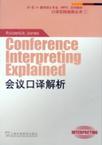会议口译解析
出版时间:2008 出版社:外教社 作者:罗德里克·琼斯(Roderick Jones) 页数:146
Tag标签:无
内容概要
会议口译实践对外行来说很神秘,但若解析得当,其中的技巧还是可以掌握的。《会议口译解析》通过对笔记、信息重组、切分长句技巧、简化、概括、预测策略等的阐述,以及对应对各类翻译难题的职业窍门的说明,详细介绍了交替传译和同声传译的实务技能。书中每一章节都提供了大量的英语原文实例,有些例子是按照其他语言的句法和语法用英语表达的。 尽管《会议口译解析》是一本实践指导书,较少涉及翻译理论,但书中包含了诸如意义单元、翻译单元和话语结构等概念的说明;对一些更有争议的问题,如省略、翻译错误的道德规范等,也提出了自己的看法。书中还评价了会议口译的乐趣,并提供了术语表和进一步阅读的参考书目。总而言之,《会议口译解析》填补了英语出版界在口译方面的空白,为初学者提供了实用的入门指导,对教师而言则是便捷的参考书。
作者简介
罗德里克·琼斯(Roderick Jones)在布鲁塞尔担任欧盟职业译员长达19年,并担任欧盟会议译员培训工作。
书籍目录
Foreword1. Introduction What Is an Interpreter? What Is Conference Interpreting? The Context of the Conference Interpreter's Work Definitions and Examples Used in this Book2. The Basic Principles of Consecutive Interpreting Understanding Analysis Analysis of Speech Type Identification of Main Ideas Analysis of Links Memory Re-expression3. Note-taking in Consecutive Interpreting Practical Points for Note-taking What to Note How to Note Abbreviations and Symbols The Language in Which to Note When to Note How to Read Back Notes4. Simultaneous Interpreting The Acoustic Difficulties of Simultaneous Interpreting The Technique of Simultaneous Interpreting When to Start Speaking ? Reformulation The Salami Technique Efficiency in Reformulation Simplification Generalization Omission (Under Duress) and Fast Speakers Summarizing and Recapitulation Explanation Anticipation What if I Make a Clear Mistake? What if the Speaker Makes a Mistake ? Avoiding Committing Yourself Metaphors and Sayings Using 'Pat phrases' Intonation, Stress and Pauses Numbers 'Retour' Relay Concluding Remarks on Simultaneous Technique5. The Pleasure of InterpretingGlossaryFurther ReadingIndex
章节摘录
A number of readers may be annoyed that the above discussion of the basicprinciples of consecutive has been carried out to a large extent as if notes didnot exist. One may have gleaned the impression that the interpreter was to ana-lyze and memorize speeches of up to five minutes without any real assistancefrom notes. It is obvious that none but exceptional interpreters can be expectedto work in that way: our presentation in the previous chapter was merely de-signed to put note-taking in the right perspective. The essential part of a consecutive interpreter s work is done in the activi-ties already described: understanding, analysis, re-expression. If these are notdone correctly, the best notes in the world will not make you a good inter-preter. Notes are no more than an aid to enhance the work done on the basis ofthese three key components. They are not an end in themselves, but a meansto an end. The interpreter who invests too much in their notes is running a twofoldrisk. First, by trying to note as much as possible in a form as close as possible tothe original, their notes may become a form of shorthand, a mere transcriptionof the sequence of words used by the speaker. Such notes will influence theinterpreter when they are reproducing the speech, and their version will be toomuch a transliteration of the original, not a re-expression of its ideas. Second, and more seriously, the interpreter who relies too much on theirnotes will have paid insufficient attention to genuine understanding and analy-sis while listening to the speech. They are therefore capable of being superficial,of making serious errors, even of contradicting themselves, insofar as the speechfor them is no longer a coherent whole but a series of sentences to be repro-duced automatically. They are, so to speak, flying blind. Having sounded these warning notes about the attitude to take to notes, andthe risks involved in their abuse, what then is the purpose of taking notes? The first and most obvious use of notes is to relieve memory. However wellthe interpreter may analyze a speech and order its ideas with a view to theirrecall (interpreters memory), there will still be too many elements in a five-minute speech for an interpreter to recall everything. This is particularly true ifa speech contains numbers, names, lists and so on, since such elements cannotbe recalled on the basis of analysis and logic. Further, if the interpreter devotestheir intellectual energies to remembering, say, a list of chemicals, this maydistract them from the key task of listening attentively to what comes next. Bynoting things in such a way that they know when and how they fit into thespeech, the interpreter need not burden their memory with such information;they can continue to devote their mental faculties to listening actively to the restof the speech.
图书封面
图书标签Tags
无
评论、评分、阅读与下载
用户评论 (总计22条)
- 我自己学过觉交替传译 同声传译 自己在做翻译 可是很想知道联合国欧盟这种真正专业的地方人们都是怎样学习 怎样工作的 我也希望通过该书的学习 真正学到这些顶级议员的经验 非常棒自己会有很大提升
- 上外考研规定教材,不过对于口译自学者会有一定的帮助,要好好读完。
- 书比较簿,还没看呢,上外的参考书,不会差的
- 可以一买,书很不错。8#
- MTI教材
- 考试用··好东西 一天就送到了··吓我一跳·以前都不这样的··
- 虽然有点枯燥,但内容很还不错~~
- useful . for self improvement .
- 全英文的,但是挺好理解的
- 送货人员态度很好
- 老师推荐买的好
- 内容是全英文的,作为翻译专业研究生的教材,英语专业的学生或是有一定水准的自学人士都可以从中得到不少启发。
全书并不是操练为主的练习手册,而是笔者经验漫谈式的总结,对于有口译实战经验的人来说,参阅此书能够很好的提升自己对会议口译的理解。 - 不错,提供一个guidline
- 给别人订的,书的内容应该没有问题,表面就不在乎了,可以
- 书不错,就是收到时封面不太干净。
- 很薄的书,难度也不是很大,适合自学。
- 很好,没有想象中那么厚呀
- what is it talking about?
- 考研用的,对口译研究的人很有用,全英文的,不过不是很难懂
- 这本书不错,讲的浅显易懂,还能反复琢磨
- 讲同传的篇幅比较多
- 帮别人买的,人家说还好。
相关图书
- 房地产权属管理疑难问题解析3 (其他)
- 中国民族学与人类学科文献目录索引汇编
- 中国吸收FDI
- 精通Windows Vista实用技巧1300招
- 手绘动画实例教程
- 日产车系汽车电脑维修图集
- 多媒体教学软件设计与开发
- 法语入门
- 双城记
- 英语专业新题型巅峰突破-8级听力
- 少年儿童安全知识手册
- 中国卷.桃花扇-中外传世名剧
- 语文复习训练
- 新税收政策与会计操作实务(上、下)
- 九十年代日记
- 脑筋急转弯
- 中文版AutoCAD 2009机械图形设计
- 乒乓球裁判通级指导
- 二年级数学上
- 工程力学基础
- 新编日语同步辅导及随课拓展练习
- 北京信息科技大学经济管理学院论文集
- 道教碑
- 黄金分割习字格标准字帖
- Pro/ENGINEER Wildfire产品造型设计
